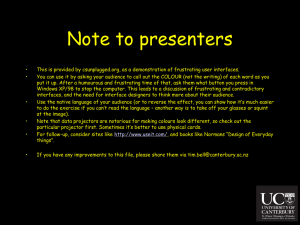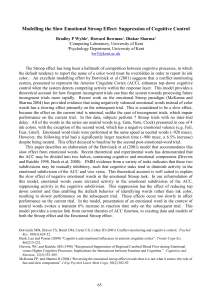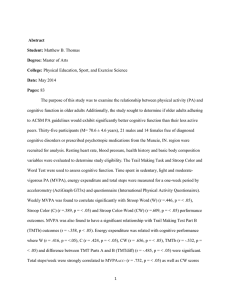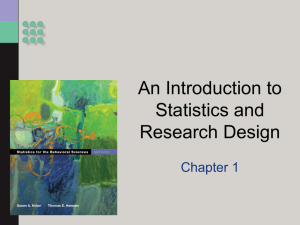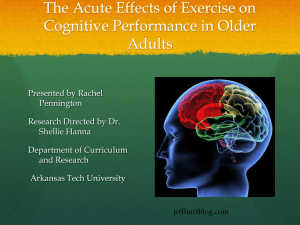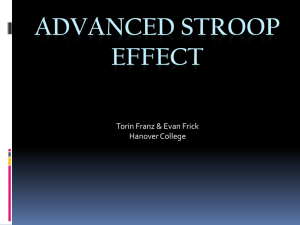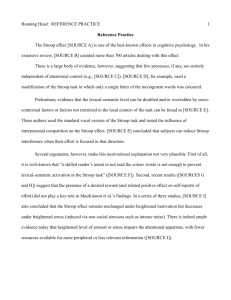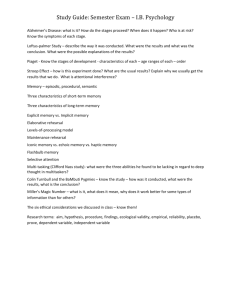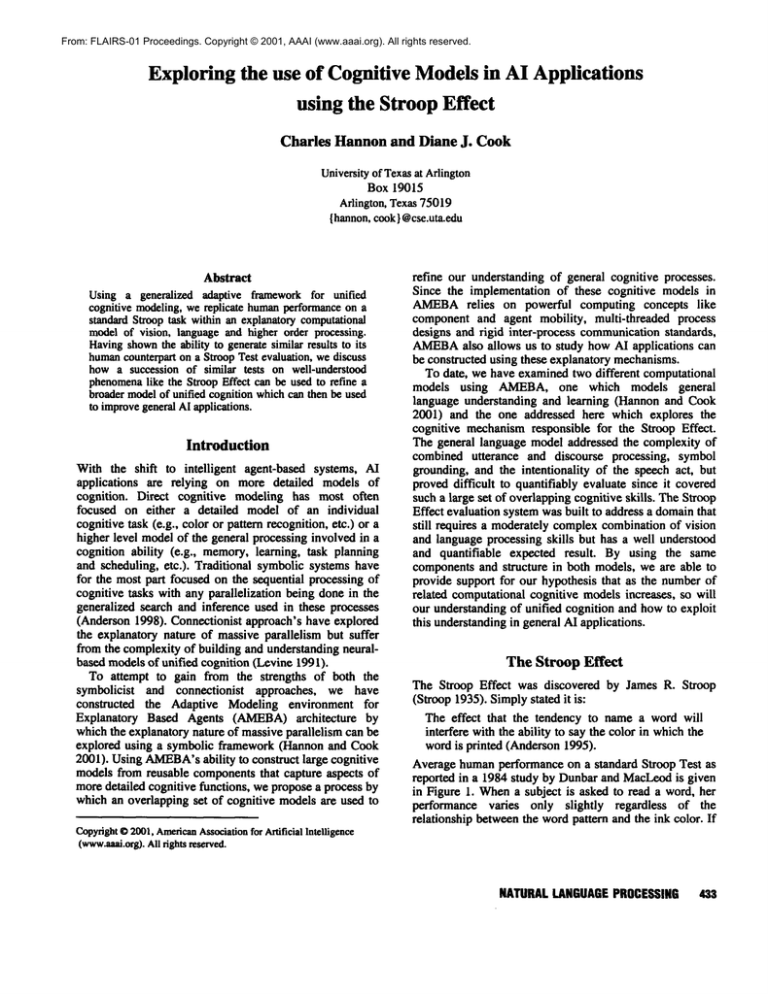
From: FLAIRS-01 Proceedings. Copyright © 2001, AAAI (www.aaai.org). All rights reserved.
Exploring the use of Cognitive Modelsin AI Applications
using the Stroop Effect
Charles
Hannon and Diane
J. Cook
Universityof Texasat Arlington
Box 19015
Arlington, Texas75019
{hannon,cook} @cse.uta.edu
Abstract
Using a generalized adaptive frameworkfor unified
cognitive modeling,we replicate humanperformanceon a
standard Stroop task within an explanatorycomputational
modelof vision, language and higher order processing.
Havingshownthe ability to generatesimilar results to its
humancounterpart on a Stroop Test evaluation, wediscuss
howa succession of similar tests on well-understood
phenomena
like the Stroop Effect can be used to refine a
broader modelof unified cognitionwhichcan then be used
to improvegeneralAI applications.
Introduction
With the shift to intelligent agent-based systems, AI
applications are relying on more detailed models of
cognition. Direct cognitive modeling has most often
focused on either a detailed model of an individual
cognitive task (e.g., color or pattern recognition, etc.) or
higher level modelof the general processing involved in a
cognition ability (e.g., memory,learning, task planning
and scheduling, etc.). Traditional symbolic systems have
for the most part focused on the sequential processing of
cognitive tasks with any parallelization being done in the
generalized search and inference used in these processes
(Anderson 1998). Connectionist approach’s have explored
the explanatory nature of massive parallelism but suffer
from the complexity of building and understanding neuralbased modelsof unified cognition (Levine 1991).
To attempt to gain from the strengths of both the
symbolicist and connectionist approaches, we have
constructed the Adaptive Modeling environment for
Explanatory Based Agents (AMEBA)architecture
which the explanatory nature of massive parallelism can be
explored using a symbolic framework (Harmon and Cook
2001). Using AMEBA’s
ability to construct large cognitive
models from reusable componentsthat capture aspects of
more detailed cognitive functions, we propose a process by
which an overlapping set of cognitive models are used to
Copyright
©2001,American
Association
for ArtificialIntelligence
(www.aaai.org).
Allrightsreserved.
refine our understanding of general cognitive processes.
Since the implementation of these cognitive models in
AMEBA
relies on powerful computing concepts like
component and agent mobility, multi-threaded process
designs and rigid inter-process communicationstandards,
AMEBA
also allows us to study how AI applications can
be constructed using these explanatory mechanisms.
To date, we have examinedtwo different computational
models using AMEBA,one which models general
language understanding and learning (Hannon and Cook
2001) and the one addressed here which explores the
cognitive mechanismresponsible for the Stroop Effect.
The general language model addressed the complexity of
combined utterance and discourse processing, symbol
grounding, and the intentionality of the speech act, but
proved difficult to quantifiably evaluate since it covered
such a large set of overlappingcognitive skills. The Stroop
Effect evaluation system was built to address a domainthat
still requires a moderately complexcombinationof vision
and language processing skills but has a well understood
and quantifiable expected result. By using the same
componentsand structure in both models, we are able to
provide support for our hypothesis that as the number of
related computational cognitive modelsincreases, so will
our understanding of unified cognition and howto exploit
this understandingin general AI applications.
The Stroop
Effect
The Stroop Effect was discovered by James R. Stroop
(Stroop 1935). Simplystated it is:
The effect that the tendency to name a word will
interfere with the ability to say the color in whichthe
word is printed (Anderson 1995).
Average humanperformance on a standard Stroop Test as
reported in a 1984 study by Dunbar and MacLeodis given
in Figure 1. Whena subject is asked to read a word, her
performance varies only slightly regardless of the
relationship betweenthe wordpattern and the ink color. If
NATURAL
LANGUAGE
PROCESSING 433
9OO
betweenspatial and semantic information (Virzi and Egeth
1985). MacCleod and Dunbar have been able to show
Stroop Effect on a learned task other than reading which
has little or no language processing component(MacCleod
and Dunbar 1988). These studies would seem to indicate
that any observedtranslation interference is occurring at a
conceptual level below the language-processing layer.
Brega and Healy provide evidence that a sentence
containing color descriptions appears to also generate
Stroop interference (Brega and Healy 1999), hut it is not
clear whether this type of interference results from the
same mechanismas the word pattern interference.
WordReading
,-, 8OO
7OO
’.~ 600
g
~’ 5oo
AMEBA
Architecture
4oo
)
Congruent
Control
Conflict
Figure 1. Stroop Task Performance
(Anderson 1995)
the subject is ask to name the ink color of a word, the
meaning of the word will have a major affect on the
response time. Congruent combinations, where the word
pattern is the nameof the color of the ink, will improve
performance over control cases where the word pattern is
not a color name. Conflicting combinations, where the
word pattern is the nameof a color other than the color of
the ink, will significantly interfere with the color-naming
task.
Researchers have attempted to both clarify the scope of
the phenomenaand to create a neuropsychological model
of an explanatory mechanism. While most research
supports the theory that the automaticity of reading
interferes with the procedural task of color naming, some
argue that the interference on the color namingtask is a
result of the word’s pattern and color forming a mental set
(Besner, Stolz, and Boutilier 1997). There is somedebate
in both theories as to wherethis interference occurs.
Studies on the effect of frontal lobe lesions indicate an
increased rate of interference
on the Stroop test
(Shimamura, 1995). This would seem to indicate that
patients with frontal lobe damagehave more difficulty in
inhibiting the learned task of reading, although this
damagecould also be directly effecting attention control
during the visual information encoding process. Studies of
the effect of prefrontal lobe lesions whichdemonstratethat
patients exhibit attention difficulty on similar task to the
Stroop task wouldtend to support this later view (Knight
and Grabowecky1995).
In building a neuropsychological model to explain the
Stroop effect, Virzi and Egeth used differences in
performance based on the way the subject receives the
stimulus and reports the results to suggest that the primary
interference occurs during the translation mechanism
434
FLAIRS-2001
The AMEBA
architecture represents the refinement of
generalized parallel tools to produce an environment for
testing cognitive theories and building AI applications
based on these models. The architecture runs on a SMP
cluster using a Beowulf-like connection scheme of
multiple high-speed networks.
AMEBA
attempts to capture the explanatory force of a
connectionist neural model while allowing the use of the
better-understood representation and reasoning methodsof
symbolic AI. From a system perspective, it attempts to
provide processor transparency within a parallel system
and a flexible
method of process and knowledge
management. The key element that supports these
requirements is the etheron process template. An etheron
provides a container for an instance of any inference or
routing mechanismneeded by the system. Once contained,
the etheron supports the mechanismwith, 1) a standard
way to load and store knowledge, 2) interfaces
to
AMEBA’s
managementtools and 3) a generalized set of
communicationchannels for talking with other etherons.
AMEBA
models draw their explanatory depth from the
environment’s ability to support hierarchical cognitive
processing. Using adaptive distributed processing and
generalized inter-process
communication, cognitive
functions can be modeledat different levels of abstractions
without changing the logical relationship between these
functions. Thus, a function like the conceptual reasoning
about the world and self can be simulated with a reasoning
and knowledgestorage system which has far less capacity
than that of a real human.This allows us to preserve the
overall model’s explanatory depth, as long as we preserve
explanatory relationships between cognitive components.
To ensure that we preserve these relationships,
our
modeling research is driven by both the evidence from
experimental psychology regarding the architecture of the
mind and the evidence from neuro-physiology regarding
the architecture of the brain.
The Stroop Test System Design
In developing a computational modelof the Stroop effect,
our goal was to embedthe resulting modelin as realistic a
modelof unified cognition as possible. Therefore, we tried
to preserve as muchas possible of the overall organization
and operation of the components used to study the
language understanding
and learning since these
components had already been shown to generate
explanatory results. The resulting Stroop Test Response
Evaluation Sub-System(STRESS)is presented in Figure
STRESSprovides the flexibility to adaptively model a
cognitive task by allowing the inference or knowledge
used in one etheron to be changed without impacting the
rest of the system. This ability was used during the
modeling of the Stroop Effect to refine both the
interactions between the Task and Concept reasoners and
the internal actions of these two critical components.
STRESS
consists of three agents, l) the Researcher, 2)
the Evaluation Tool, and 3) the Subject. Each labeled
ellipse in the figure represents a process component(an
etheron) in the sub-system. A total of 26 etherons were
used to model the sub-system, the major portion of these
making up the Subject agent. Most of the Subject’s
componentsare the same as the ones used by a child agent
in the language understanding and learning system. The
basic differences betweenthe Subject and a child agent of
that system are; 1) the child agent had more Higher Order
Process (HOP)reasoners to support tasks like discourse
analysis, socialization and intentionality and 2) the child
agent’s vision components simulate simple object
recognition while the Subject agent’s vision system is
based on a very simple emulation of a human eye and
visual cortex.
U ttcrance
Reason
Knowledge
Both the child agent of the general language modeland
the Subject agent of STRESSuse a Concept Reasoner
based on a semantic network that supports temporal-modal
relationships between concept nodes. At a knowledge
level, the Concept Reasoner of the child agent and the
Subject are quite different.
While the knowledge
representation of the base reasoner has been used with very
large networks, the STRESSconceptual network is quite
small, containing less than a hundred concepts. This is
because the child’s Concept Reasoner is primarily used to
store and retrieve all of the world knowledgeneeded to
conduct a child-like discourse while the Subject’s reasoner
is primarily used to simulate both the constructive and
destructive interference of spreading activation within the
reasoner’s semantic network. While the knowledgestored
in the utterance processing etherons of the Subject agent is
the same as the child agent, the STRESS
system only uses
the natural language interface betweenthe Researcher and
Subject to allow the Researcher to pass simple instructions
to the Subject regarding the testing process.
Inter-agent communication in STRESSpasses three
types of information (natural language, vision information,
and time synchronization) to and from different etherons
within the same agent. This information is channelized in
the inter-agent
communication scheme to allow
heterogeneous message passing between different
interfaces in each agent. Intra-agent communicationin all
three STRESSagents relies on the Stimuli Routing
Network (SRN) provided by AMEBA.Any etheron
labeled as either a SRNor an Agentin Figure 2 is a SRN.
Generation
Reasoner
Utteranc
Generation
I
[
Language
/
Time Sync
L .
Language
.
--
Subje
xt
Processing
SRN
Language
Syntax
Figure
ime Sy
2. The STRESS Model
NATURAL
LANGUAGE
PROCESSING 43S
An SRNis best viewed as a special purpose etheron
designed to support dynamic name-based routing of
messages. (In reality, they are built from the samelibrary
of functions as any other etheron but just do not contain a
very complex inference method and have all of their
communicationchannels turned on.) SRNscan be used to
route point-to-point, locaicast, and broadcast messages.
They are also designed to support message filtering and
redirection;
however, in STRESSwe only used their
localcast and broadcast capability.
All etherons labeled as I/F in Figure 2 serve the basic
purpose of converting between inter-agent messages on
one channel to stimuli messagesused internally within an
agent. Theyare best viewedas simulations of sense sensors
and motor actuators. Anyetheron labeled as an Analyzer is
a coded response mechanism (or non-generic reasoner)
based on AMEBA’s
generic database lookup tool. The
Task Reasoner uses AMEBA’stemporal logic based
production system. The Subject’s Utterance Generation
and Semantics Reasoners are based on the same semantic
networkreasoner that is used by the ConceptReasoner.
The Stroop Test System Operation
The heart of the Stroop Effect cognitive mechanism in
STRESSis the Concept and Task Reasoners. The other
etherons provide both cognitive task and implementation
support for these two components. Table I provides a
summaryof the relevant stimuli types used in STRESS.
The STRESSsystem’s two special purpose user interfaces
are then attached to the Researcher and Evaluation Tool
agents using the same user interface. At the Evaluation
Tool interface a word pattern can be selected and the ink
color of the worddefined. This information is graphically
presented to the user. At the Researcher interface, the
Subject agent can be told (using natural language) to attend
to either the word’spattern or its ink color. The user can
then send the visual stimulus to the Subject by pressing a
Send button.
Whenthe Send button is pressed, the word pattern and
its color are sent in a single messageto the Subject as four
values, the Red, Green, and Blue (RGB)values of the color
and a pattern ID. At the same time, a Time Sync message
is sent to the Researcheragent.
Whenthe message containing the RGBvalues and
pattern ID is received by the Vision I/F etheron of the
Subject agent, it is turned into a SEEstimulus which is
localcasted to the Color and Pattern analyzers. The Color
Analyzer mixes the RGBvalues to calculate a spatial
concept of the resulting color and broadcast this result in a
COLstimulus. The Pattern Analyzer uses the pattern ID to
generate a semantic concept of the word and broadcast this
result as a PATstimulus.
While every etheron in the Subject agent sees both the
COLand PAT stimuli,
only the Task Reasoner does
anything with them. What it does depends on its current
mental state which can be toggled between a word reading
436
FLAIRS-2001
Table 1. Relevant Stimuli Types used in STRESS
Stimuli
Label
COL
PAT
?REF
RSP
SEE
SEM
STM
Information
Contained
A spatial color concept
A semantic word pattern concept
A conceptual relationship
Question about a conceptual relationship
A deep structure verbal response
Rawvision data
An utterance semantic relationship
A time synchronization pulse
and color matching task by the SEMstimuli generated as a
result of the processingof an imperative utterance from the
Researcher. In the word reading task mode, the Task
Reasoner generates and broadcasts a RSP stimulus
containing the semantic concept of the word pattern. This
RSP is converted by the Utterance Generation etheron
cluster into an utterance sent to the Researcheragent.
In the color matching task mode, the Task Reasoner
generates and broadcasts a ?REFstimuli containing the
question:
?word-pattern color-name spatial-color
Whenthe Concept Reasoner gets the ?REFstimulus, it
activates both the word-patternand spatial-color concepts,
then looks to see if there is a color-name intersection
between the two concepts (i.e., you can follow a relation
chain between the two concepts that contains any number
of is-a relationships but one and only one color-name
relationship). This intersection will only exist in the
congruent case. It then broadcasts a REF(i.e., the answer
to a ?REF)stimulus that says that the word-pattern is the
color name.
If the color-name intersection fails, the Concept
Reasoner broadcasts a REFstimulus indicating that no
intersection exists. Accordingto the theory of spreading
activation, if the word-patternis a conflicting color-name,
its activation should inhibit all other color-nameconcepts
for a given set of time. This is simulated in the Concept
Reasonerby testing the relation, word-pattern is-a colorname, and stalling the inference thread if this question
answers True.’ If the Task Reasoner gets the REFstimulus
t While stalling
the thread of execution
which is
responsible for color lookup in the concept reasoner might
at first appear to be simply a trick to makethe simulation
work, at the model’scurrent level of abstraction this is the
best way to simulate the expected result of spreading
activation on a color-lookup task. A more general
componentwouldneed to control the spreading activation
at an individual-concept level, but the resulting method
wouldstill be only a simulation of the actual brain process
even if it was completelyconnectionist-based.
reporting failure, it sends a ?REFstimuli containing the
question:
130
spatial-color spatial-color-of ?Color-Name
120
Whenthe Concept Reasoner gets this ?REFstimulus, it
tests for a spatial-color-of intersection betweenthe spatialcolor and the Color-Name(the root concept of all color
names) concepts. This intersection cannot fail (since
knowthe nameof all spatial colors generated by the Color
Analyzer) but the time at which the test starts can be
delayed if the word-pattern concept was a color name
since the inference thread maystill be stalled. Thus, the
color name for both the control and conflict case will be
foundin this secondinference, but in the case of a conflict,
the inference has to wait until the simulatedinhibiting field
is removedfrom all other color names.
Whenthe final REFstimulus containing the color name
answer is broadcast by the ConceptReasoner, this stimulus
is detected by the Task Reasoner which has been primed to
expect it (whenit sent either the first or second ?REF).
Since this is nowa semantic concept, the Task Reasoner
generates and broadcasts a RSPstimulus containing the
semantic concept of the color name. This RSPis again
converted by the Utterance Generation etheron cluster into
an utterance sent to the Researcheragent.
When the Language/Time Sync IF ethernon of the
Subject agent gets the wordto be sent to the Researcher. it
sends this over the language channel of the inter-agent
messaging system, It also sends a Time Sync messageover
the time channel. Whenthe Researcher agent’s Language
I/F etheron gets the response word, it is converted to an
utterance stimulus which is displayed at the Researcher
agent’s user interface. At the Time Sync I/F, the Time
Sync message is compared to the one sent by Evaluation
Test agent and a duration of test stimulus is sent to the
Researcheragent’s user interface.
Results
STRESS was tested on an SMPcluster of 16 total
processors. The topology of this system is eight twoprocessor SMPmachines connected via two switched and
one hubbed 100baseT networks. Test were run on 1, 3 and
4 SMPmachines by first dividing the model across agent
boundaries, and then, dividing the Subject agent across two
SMP machines. In our language understanding
and
learning system, we have been able to see some speed up
by breaking the system across both agent and etheron
cluster boundaries; however, STRESS
is not big enough to
gain muchdirect speed up.
The results of a series of tests running STRESSon a
single SMPmachine are presented in Figure 3. These
values represent the average trial time of the values that
clustered around the mediantime of test. This methodwas
used instead of a straight average since someevaluation
tests took at muchas three times as long as the median.
8
90
.~
80
~ 70
5O
4O
I
Congruent
I
Control
t
Conflict
Figure 3. STRESSPerfornmnce
While access to the high-speed networks being used to link
our SMP
cluster is carefully controlled, it is suspectedthat
these long test times were a result of networkinterference
cause by utility messageswithin the network.
As Figure 3 demonstrates, we were able to get results
which are in many ways similar to the average human
performanceon the Stroop test. Webelieve the differences
in both the relative time between the reading and color
namingtask and the differential impact of constructive and
destructive Stroop interference can both be explained by
the crudeness of our current computational model of
unified cognition. The current model provides far too
much independent control over the time that the
mismatched color inhibitor field remains active in the
conceptual reasoner, but we feel that we have taken the
necessary steps to justify that our choice of inhibit time is
relative to the sum of the rest cycles of the expected
numberof neurons that would chain-fire during a similar
activity in the brain. While the mechanismwe used for
generating the Stroop Effect cannot be fully provenby this
current research, the current research does provide some
interesting results which seem to support the following
conclusions:
¯ the difference in word pattern reading and color naming
can be explained by the amount of effort required to
translate the spatial color concept to a semantic concept
representing that color.
¯ the constructive and destructive Stroop Effect on the
color-naming task can be partially explained by the
concept priming and the generation of an inhibiting field
on similar concepts suggested by the Spreading
Activation Theory.
¯ symbolically based testing environments, like AMEBA,
can be used to demonstrate these types of analytical
results within the context of a larger unified model.
NATURAL
LANGUAGE
PROCESSING 437
Future Work
The current work with STRESScan be extended to gain a
further understanding of both the Stroop Effect and its
impact on a broader unified modelof cognition. One clear
extension would be to study the effect of different
modalityrelationships (e.g., spatial-to-semantic, spatial-tospatial, etc.) between the input stimuli and the output
response. The effect of modality has been addressed in a
numberof psychologyexperiments so there already exist a
large body of evidence on which to base such a model. The
explanatory depth of the method used to simulate
spreading activation in the conceptual reasoner also needs
to be improvedto support a moregeneral simulation of this
phenomenon and to test the assumptions we made in
selecting an appropriate inhibitor field activation time.
While AMEBA
is designed to allow models to be
further and further refined, our current ability to model
general vision, language and higher order processes can
already be broadened and refined based on the current
SwoopEffect model. As expected, STRESSpointed out
several minor weaknessesin our original language learning
and understanding model. It is this interplay of models
which we hope will allow AMEBA
to contribute to the
overall field of cognitive science.
The next detailed modeling domain we would like to
address is the Wisconsin Card Sorting Test (WCST).The
WCST
will provide an opportunity to study such things as
metal sets and task planning. In addition, the further
modelingof language generation needs to be addressed.
Conclusion
STRESSshows that it is possible to build a cognitive
model of the Stroop Effect that can be examined
symbolically. While it was primarily designed to further
study AMEBA
as a modeling environment and to discover
weaknesses in our general language model, the model does
point out which formal theories of the Stroop Effect
cognitive task seem most reasonable from an early
computation
model of its mechanism. As more
computational models of well-known human performance
test are studied within the commonframeworkprovided by
AMEBA,
our ability to improve general AI applications
based on these models should continue to increase. We
maynever need to directly simulate the Stroop Effect in an
AI application, but an understanding of how it can be
modeled should aid in the construction of language and
vision processing elements for future AI-basedinterfaces.
References
Anderson, J. R. 1995. Cognitive Psychology and its
Implications. NewYork: W. H. Freeman and Company.
Anderson, J. R. and Lebiere, C. 1998. Atomic Components
of Thought. Hillsdale, NJ: LawrenceErlbaumAssociates.
438
FLAIRS-2001
Besner, D., Stolz, J. A., and Boutilier, C. 1997. The Stroop
effect and the myth of automaticity. PsychonomicBulletin
& Review, 4, 221-225.
Brega, A.G. and Healy, A.F 1999. Sentence Interference in
the Stroop Test. Memory& Cognition 27(5):768-778.
Harmon,C. and Cook, D. J. 2001. Developing a Tool for
Unified Cognitive Modeling using a Model of Learning
and Understanding in YoungChildren. To appear in The
International Journalof Artificial Intelligence Tools.
Knight and Grabowecky1995. Escape from Linear Time:
Prefrontal
Cortex and Conscious Experience.
In
Gazzaniga, M. S. (Editor-in-Chief)
The Cognitive
Neurosciences. MITPress: Cambridge 1357-1371.
Levine, D. S. 1991. Introduction to Neural and Cognitive
Modeling. Hillsdale, NJ: LawrenceErlbaumAssociates.
MacCleod and Dunbar 1988. Training and Stroop-like
interference: Evidence for a continuumof automaticity.
Journal of Experimental Psycholog: Learning, Memory
and Cognition 14:126-135.
Martindale, C. 1991. Cognitive Psychology, A NeuralNetwork Approach. Brooks/Cole Publishing Co., Pacific
Grove, CA.
Shimamura, 1995. Memoryand Frontal Lobe Function. In
Gazzaniga, M. S. (Editor-in-Chief)
The Cognitive
Neurosciences. MITPress: Cambridge803-813.
Stroop, R. 1935. Studies of Interference in Serial Verbal
Reactions. Journal of Experimental Psychology 18:643662.
Virzi, R. and Egeth, H. 1985. Towarda translational model
of Stroop interference. Memory& Cognition 13(4):304319.

